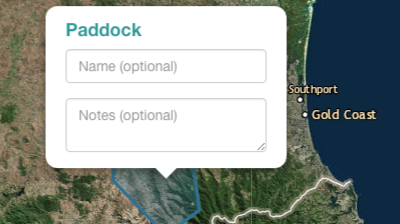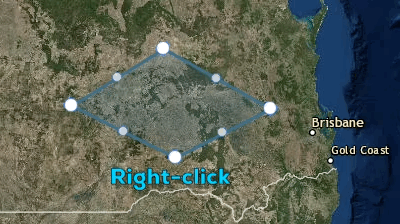
Click this button to zoom in on the map, alternatively use the mouse wheel.
Click this button to zoom out on the map, alternatively use the mouse wheel.
Clicking this button enables drawing mode, you can then "left-click" on the map to place vertices.
To complete the polygon, click again on the first vertex; this will finish drawing and create a paddock.
Once you've drawn a paddock, you can click on it to open a popup, which allows adding names/notes.

This tool allows you to pinpoint where water points are located on your property.
Once this mode is enabled, click on adjacent paddocks you'd like to merge into a single paddock.
Clicking the control icon again will disable merge mode, and apply the merge.
After enabling this mode, you can draw a polyline through existing paddocks where you'd like to divide them.
For best results, place first and last vertices outside the paddock(s) you're wanting to divide.
Finish drawing the line by double clicking, or clicking an existing vertex a second time.
If an area of your paddock should be excluded, use this tool to "cut" out that portion.
Enabling edit mode allows you to do the following:
To remove a vertex from a line or polygon, "right-click" the vertex icon.

While in this mode, clicking on features will remove them from the map.

Toggling this mode will change whether vertices snap to other features.
Hitting save will store your properties/scenarios in the cloud.
This allows you to resume editing your map at a later time, or from another device.
This allows you to undo your most recent changes.
If you change your mind after undoing changes, you can reapply them using this.
Here you can choose which layers/overlays on the map are visible.
Toggles visible layers to switch between seleting log plans and adding them as paddocks, or detecting land types so you can override land types when requesting reports.
Brings up this information.
You can create a number of properties under your login name. A property can have multiple case studies (e.g. alternate paddock configurations such as add water points or exclusion zones).
Opens a form where you can submit requests to generate reports based on your current scenario.
This allows you to load existing geographical features from a file on your device.
Supported formats:
Once you've loaded a valid file, imported shapes will be highlighted red. Clicking on these gives you the option to "import as paddock".
You can overlay an existing GeoTIFF as a visual aid. Note that it cannot exceed 5MB file size.
The map is using EPSG:4326 projection. If your GeoTIFF has a different projection, the system will try and convert it. If the system cannot determine the projection, the render will fail.
You can download your current features in the following formats:
Zooms to your current location based on GPS position.
Here you can search by addresses, names of places/properties, and also by lot plans.
Selecting a lot plan will load the boundaries, allowing you to "import as paddock".
You can create a number of properties under your login name. A property can have multiple case studies (e.g. alternate paddock configurations such as add water points or exclusion zones).
| Property | Case Studies | Active | Actions |
|---|
In MyFORAGE, you can customise FORAGE reports by setting up your property and paddock boundary configurations. This can be done in three ways:
MyFORAGE can improve how your property is modelled for the Long-Term Carrying Capacity report, Rainfall and Pasture by Land Type report and the Pasture Growth Alert report. For your property you can:
MyFORAGE (prototype) is a joint Queensland Government and Drought and Climate Adaptation Program product. Feedback on MyFORAGE can be provided to longpaddock@qld.gov.au.


Some features are unavaiable without logging in/registering.
Creating an account is free and easy, click the register button below to get started.
